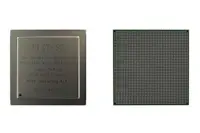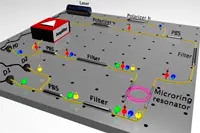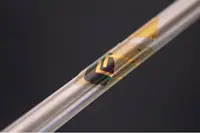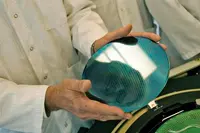Electronics News
Archive : 16 November 2015 год
 PEZY Computing has announced it is working on a MIPS64-based PEZY-SC2 family of many-core chips for supercomputers and HPC applications that will scale up to 4096 processing nodes.
PEZY Computing has announced it is working on a MIPS64-based PEZY-SC2 family of many-core chips for supercomputers and HPC applications that will scale up to 4096 processing nodes.
The 64-bit MIPS CPUs will act as the host processors for the system, making PEZY-SC2 the first generation of 64-bit HPC processors from the Japanese company.
PEZY is a fabless startup focusing on compute-intensive, highly parallel applications. The company occupies the top three spots on the Green500 list of energy-efficient HPC makers, setting a world record with the Shoubo supercomputer that consumes 7W per GFLOPS.
The MIPS architecture provides many features for HPC applications, including hardware multithreading (up to four threads per CPU), 128-bit SIMD, and full hardware virtualisation (up to 255 guest operating systems). The company says; hardware multithreading is very important since many-core chips prefer to use in-order execution cores and rely on multithreading to avoid stalling.
Author
Tom Austin-Morgan
Source: www.newelectronics.co.uk
 Researchers from RMIT University in Melbourne, led by Professor David Moss - director of RMITs MicroNano Research Facility, claim to have created photon pairs that fit on a computer chip. The team says the development could lead to the next-generation of integrated quantum optical technology, being compatible with current technology and secure communications.
Researchers from RMIT University in Melbourne, led by Professor David Moss - director of RMITs MicroNano Research Facility, claim to have created photon pairs that fit on a computer chip. The team says the development could lead to the next-generation of integrated quantum optical technology, being compatible with current technology and secure communications.
The approach used by the researchers is based on a micro-ring resonator - a tiny optical cavity - in which energy conservation constraints can be exploited to suppress classical effects while amplifying quantum processes.
They used laser beams at different wavelengths and then had to overcome the risk of the two pump beams being able to destroy the photons' fragile quantum state.
Prof Moss said: “While a similar suppression of classical effects has been observed in gas vapours and complex micro-structured fibres, this is the first time it has been reported on a chip, opening a route for building scalable integrated devices that exploit the mixing of polarisation on a single photon level.
"It also has the advantage that the fabrication process of the chip is compatible with that currently used for electronic chips which not only allows the exploitation of the huge global infrastructure of CMOS foundries, but will ultimately offer the potential to integrate electronic devices on the same chip,” he concluded.
Author
Tom Austin-Morgan
Source: www.newelectronics.co.uk
 A flexible, lightweight sensor that is said to respond rapidly to changes in body temperature has been developed by a group from the University of Tokyo. The sensor’s resistance is said to change by up to 100,000 times over a range of 5°C, allowing accurate temperature measurement without additional complicated display circuitry.
A flexible, lightweight sensor that is said to respond rapidly to changes in body temperature has been developed by a group from the University of Tokyo. The sensor’s resistance is said to change by up to 100,000 times over a range of 5°C, allowing accurate temperature measurement without additional complicated display circuitry.
The sensor is composed of graphite and a semicrystalline acrylate polymer formed of two monomers. The temperature at which the sensor is most precise can be selected by altering the proportions of the two monomers. The research group measured temperatures between 25 and 50°C, with response times of less than 100ms and a temperature sensitivity of 0.02°C. The device was also found to be stable, providing repeated readings up to 1800 times.
“By printing an array of these sensors, it is possible to measure surface temperature over a large area,” said Professor Takao Someya from the University’s Graduate School of Engineering. “Because the huge response of the sensor to temperature change allows us to simplify the circuitry, we could print our sensors onto adhesive plasters that could then monitor body temperature.”
Other possible applications include wearable electronics, where the sensor could be applied beneath fabric to measure temperature during sporting and other activities.
Author
Graham Pitcher
Source: www.newelectronics.co.uk
 Connected lighting specialist, Gooee has claimed to have created the world’s smallest sensor for LED lighting and the Internet of Things (IoT) that now includes the latest Artificial Eye technology following an exclusive agreement with DELTA Microelectronics.
Connected lighting specialist, Gooee has claimed to have created the world’s smallest sensor for LED lighting and the Internet of Things (IoT) that now includes the latest Artificial Eye technology following an exclusive agreement with DELTA Microelectronics.
The agreement creates a new ‘standard’ in sensing, data and control for the LED lighting industry, and sees Gooee becoming the sole provider of this Opto-ASIC technology to luminaire manufacturers. It also follows Gooee’s announcement of the exclusive partnership with EVRYTHNG’s IoT cloud platform, enabling it to operate tens of millions of intelligent light endpoints in a global network.
The 5 x 5mm chip boasts multiple environmental, human and LED performance sensing capabilities, the ASIC is said to detect motion, direction, ambient light, LED colour temperature variance, LED lux variance and ASIC operating temperature.
A step closer to connecting LED lighting manufacturers to the IoT with its ‘Full-Stack’ operating platform, Gooee has partnered with DELTA to focus on co-engineering and further developing more advanced sensing capabilities.
Simon Coombes Gooee’s CTO, said: “At present we are only scratching the surface in terms of what this chip can do. We are working on some really incredible functionality that will give Gooee and its customers a significant competitive advantage in sensing for the IoT.”
Gooee says it is also co-developing a Bluetooth meshing protocol with a major Wireless IC provider. This technology, along with the other on-premise components of Gooee's ecosystem, is said to allow light fixtures to communicate two-way, enabling control, sensing, human engagement and asset tracking.
Author
Tom Austin-Morgan
Source: www.newelectronics.co.uk

